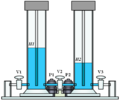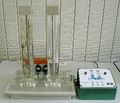Coupled Tanks V5/en
| Main page | Laboratory models | Courses | Equipment | History | Administrator | For students | Links | |
Laboratory model Coupled tanks V5 was used for the study of control engineering in The K23 laboratory in since 1991. In 2008 was reconstructed by Jozef Fetterik in his bachelor thesis [1]. The model contains 2 tanks connected by a valve. At every tank is connected one gear pump, one escape valve to the reservoir of water and the sensor of the water level. For controlling can be used PC, programmable controller, analog computer Meda or manual control.
Model isn't used for education because it have been replaced by later models Coupled tanks V1 - V4. The system isn't in present in the K23 laboratory, it will be transported there after a finalization of its reconstruction.
Construction of model
Main part of construction
As tanks are used measuring cylinders with about 2 l capacity. The reservoar with 6 l capacity is in the bottom part of model and whole model is built thereon. Working liquid is distilled water.
Valves and pumps
Valves in the model are made from glass, they are used in chemical laboratories. One valve is between tanks and another two are used like escape valves from tanks. They are supplied with reed contacts which are used for opening indication. Used pumps are gear pumps with 12V feed and 50W power input.
Sensors an control unit
For measurement the water level are used capacity sondes - coaxial capacitors. Their electronic is in boxes on measuring cylinders.
Control unit provides selection between controlling from Matlab, PLC, analog computer Meda and manual control. The main part of control unit is 8-bit processor PIC16F84A.
Useful formulae
Relation between the velocity of fluid v [m s-1] and its high h [m] is
<math>v(t)=\sqrt{2 \, g \, h(t)}~\text{.}</math>
Relation of fluid p [Pa] from the centrifugal pump and its voltage u [V] is quadratic
<math>p(t)=k \, u^2(t)~\text{.}</math>
Relation of fluid q [m3 s-1] from the gear pump and its voltage u [V] is linear
<math>p(t)=k \, u(t)~\text{.}</math>
References
- ↑ FETTERIK, Jozef. PLC riadenie modelu technologického procesu. Praha, 2008. xi, 35 s. Bakalářská práce. ČVUT-FEL, Katedra řídicí techniky. Vedoucí práce Ing. Jindřich Fuka.





